Mastering the Manda Recipe: A Culinary Journey
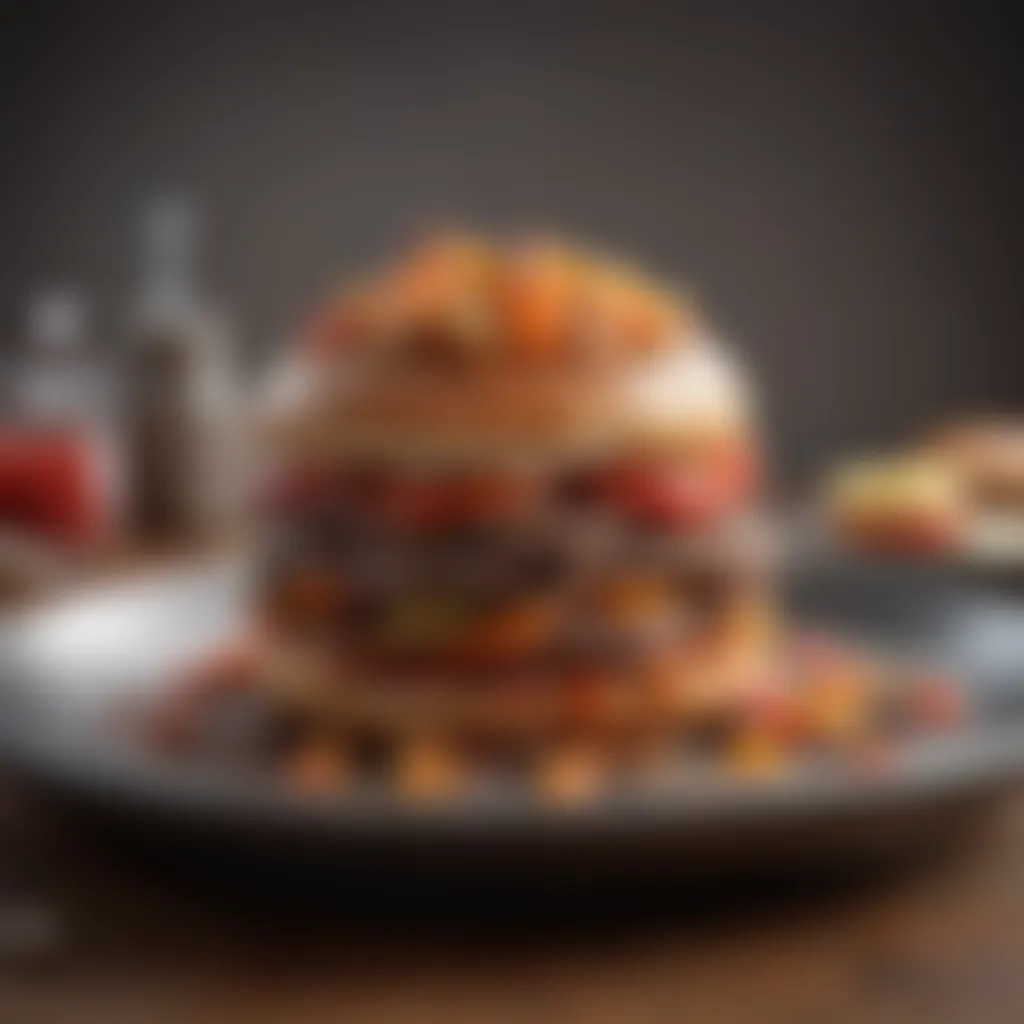
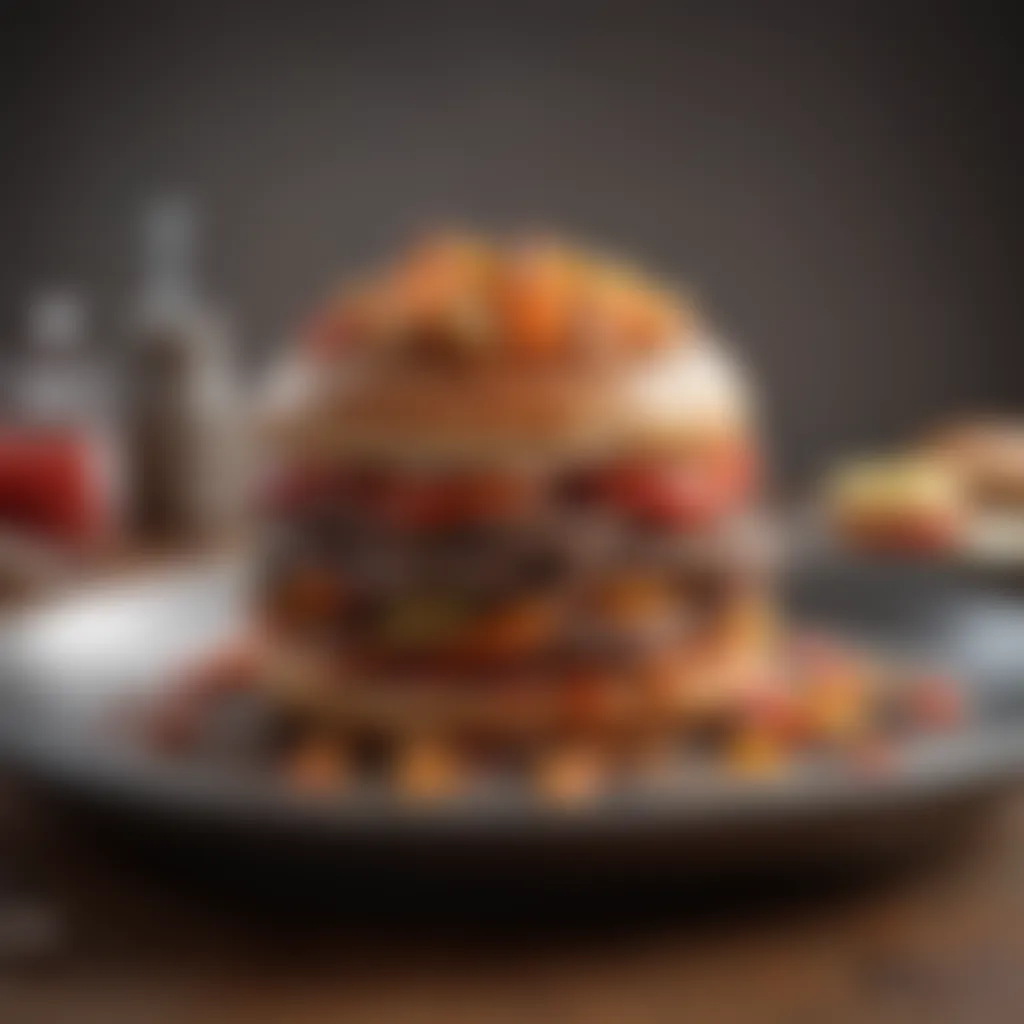
Intro
The Manda is not just a dish; it’s a narrative wrapped in flavors, history, and culture. Originating from the heart of culinary traditions, the Manda holds a significant place in various regional cuisines. Mastering this recipe involves more than just knowing ingredients; it's about understanding the rhythm of cooking and the stories each component brings to the table. This guide will take you from the first chop to the last bite, ensuring every step is as rewarding as the finished product.
Ingredients:
To create the perfect Manda, having the right ingredients is crucial. Here, we present a carefully measured list, ensuring you have everything needed for that authentic taste:
- 500 grams of wheat flour
- 1 teaspoon of salt
- 2 tablespoons of vegetable oil
- 300 ml of warm water
- 250 grams of minced meat (beef or lamb)
- 1 medium onion, finely chopped
- 2 cloves of garlic, minced
- 1 teaspoon of ground cumin
- 1 teaspoon of paprika
- Salt and pepper to taste
- Fresh herbs for garnish (like parsley or coriander)
Preparation Steps:
Taking the time to prepare your ingredients will streamline the cooking process and enhance your culinary experience. Follow these detailed instructions carefully:
- Prepare the Dough: In a large bowl, combine the wheat flour and salt. Gradually add the warm water and the vegetable oil, mixing until the dough starts to come together. Knead the dough on a floured surface for about 10 minutes, or until smooth and elastic. Cover with a damp cloth and let it rest for at least 30 minutes.
- Cook the Filling: In a skillet, heat a bit of oil over medium heat. Add the chopped onion and sauté until translucent. Stir in the garlic, cumin, and paprika, cooking for another minute. Add the minced meat, seasoning with salt and pepper, and cook until browned and fully cooked through. This step is crucial to ensure flavors meld beautifully.
Technical Aspects:
Now that we have our components set, attention to technical detail will bring your Manda to life. Here’s what you need to keep in mind:
- Temperature Settings: Ensure your cooking environment is a consistent medium heat to avoid burning or undercooking.
- Timing Specifics: Let the dough rest for at least 30 minutes. Cooking the filling should take approximately 10 minutes.
- Critical Techniques: Pay close attention when kneading the dough, as this will affect the texture of your final product.
Cooking Process:
Once you have your ingredients prepared and your techniques honed, it’s time to bring everything together.
- Roll Out the Dough: On a floured surface, divide the dough into smallballs, about the size of a golf ball. Using a rolling pin, flatten each ball into a circular shape, about 5 mm thick.
- Fill and Seal: Spoon the meat filling into the centre of each round of dough. Fold the dough over and crimp the edges together securely, ensuring no filling escapes during cooking.
- Cooking Time: Heat some oil in a pan over medium heat. Carefully place the sealed Mandas into the pan, cooking for about 4-5 minutes on each side until golden brown and crispy.
- Serving: Garnish with fresh herbs and serve hot. They can be enjoyed on their own or accompanied by a dipping sauce.
Troubleshooting Tips:
If something does not turn out quite right, don't fret! Here are some common issues and their fixes:
- Dough too sticky? Add a little more flour during kneading.
- Mandas tearing while cooking? Ensure they are sealed tightly to prevent possible openings.
- Flavor lacking? Don't hesitate to adjust seasonings according to your preferences.
Remember, every cook's kitchen is its own little universe. So do not be afraid to make changes as per your taste and style.
With this guide, you’re now armed to create delicious Manda that not only fills the belly but warms the heart.
Understanding Manda
Understanding the essence of Manda is pivotal in mastering this celebrated dish. Beyond just a culinary endeavor, it embodies a blend of history, culture, and technique that elevates it beyond mere ingredients. Grasping the significance of this dish prepares one to appreciate not only the flavors but also the traditions and stories that accompany each step of its preparation. This exploration sets the stage for a deeper connection with Manda, guiding enthusiasts toward not just making a recipe but truly experiencing its multifaceted background.
A Brief History
The history of Manda traces back to ancient times, revealing a tapestry woven with rich cultural threads. This dish, often made with simple ingredients, has roots in diverse culinary traditions across regions. It's believed that Manda was initially developed as a way to preserve food before the advent of modern refrigeration, utilizing local ingredients that could withstand time.
Stories passed down through generations highlight the role of Manda in communal gatherings and celebrations. For instance, in some cultures, Manda was essential during festivals, symbolizing unity and the sharing of abundance. Its preparation often involved entire families, turning cooking into a collective ritual, where the skills of women passed down through the ages became central. Even today, preparing Manda encases techniques that connect the present with the past, making it much more than just a meal.
Cultural Relevance
Manda holds significant cultural weight in societies where it's cherished. It’s not simply a dish to savor; it's a canvas for expressing local identities and culinary heritage. Differing regional interpretations incorporate unique spices and cooking methods, reflecting the availability of ingredients and traditional tastes.
Take, for instance, how Manda is adapted in coastal regions, where seafood finds its way into the recipe, diverging from landlocked areas that might use dried meats or legumes.
In a broader sense, the dish serves as a medium for storytelling. When people prepare and share Manda, they are narrating their history, values, and communal bonds. This culinary representation fosters an understanding of cultural diversity, reminding us that food is a universal language that connects us across borders.
"Cooking is an art, and the plate is the canvas. Manda is a masterpiece reflecting heart and heritage."
Exploring Manda is more than a journey into the kitchen. It is a pathway to understanding the collective memory and the everyday lives of those who have come before us, creating a deep-rooted appreciation for the dish and its place in our lives.
Essential Ingredients
In crafting a successful Manda, the importance of essential ingredients cannot be overstated. They are the backbone of the dish, influencing not just the flavor but also the texture and overall appeal. Without a well-thought-out selection of components, the entire cooking process and the resulting dish might fall flat. It’s not merely about gathering ingredients; it’s about selecting the right ones that harmonize with each other to create a symphony of taste.
The essence of Manda lies in its primary components, which provide the fundamental structure of the dish. Each ingredient plays a distinct role, and understanding their contributions can elevate your culinary creation from ordinary to extraordinary.
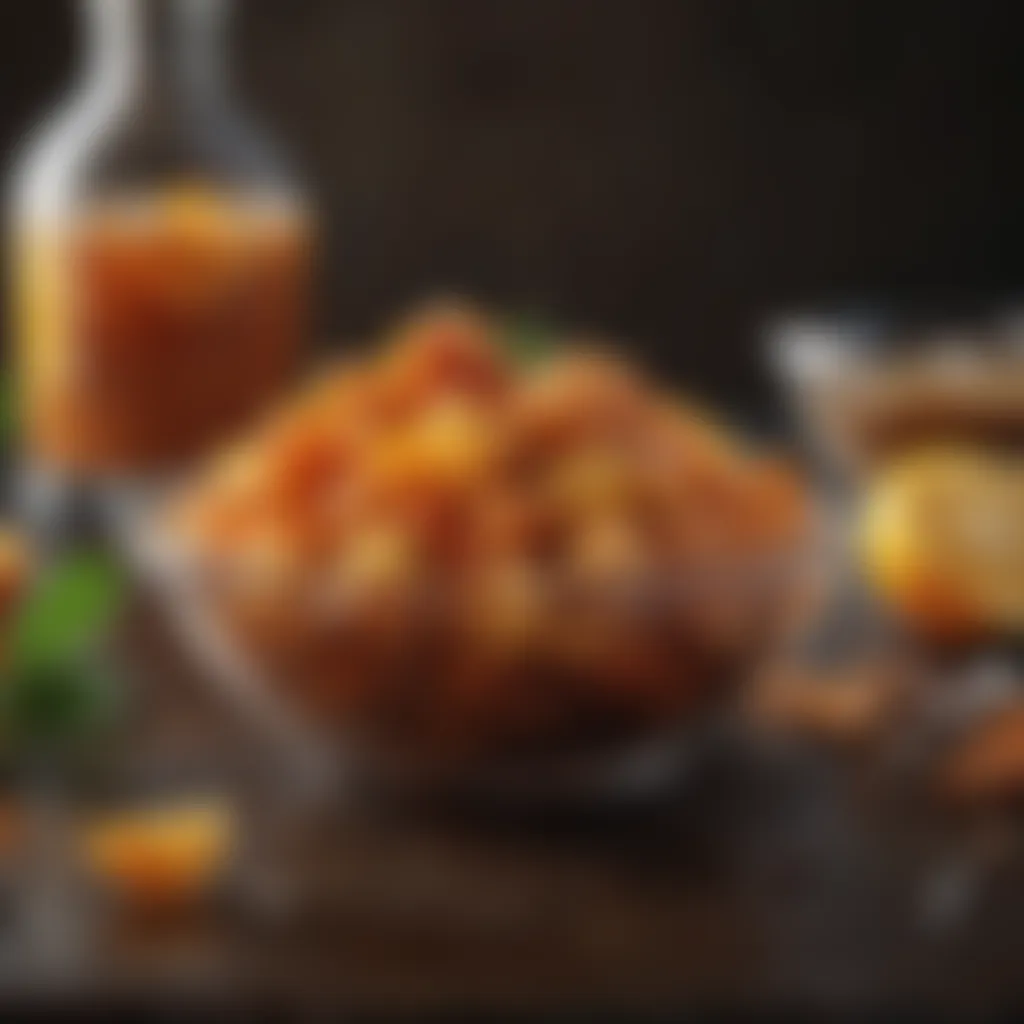
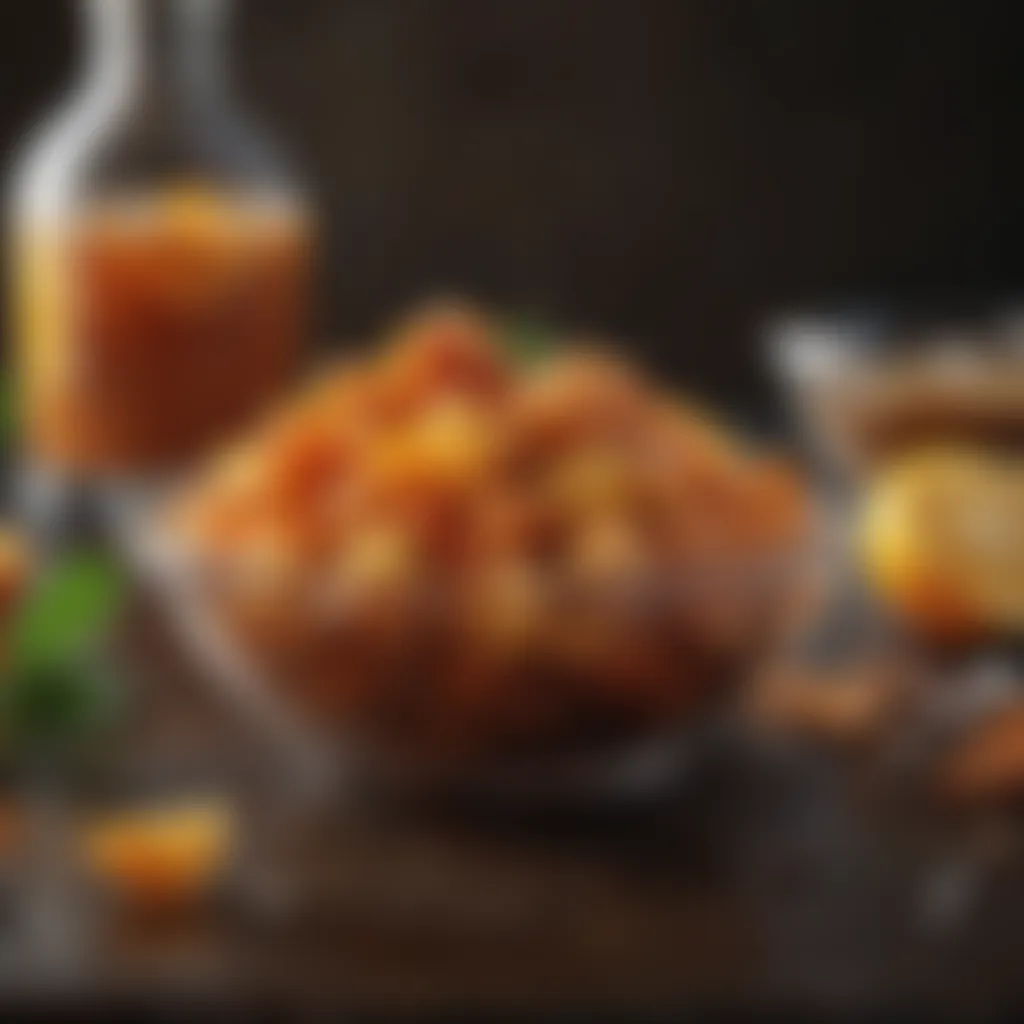
Primary Components
When we talk about the primary ingredients in making Manda, we refer to a mix of flavors, textures, and aromas that work together seamlessly. Typically, the core components include:
- Rice Flour: This forms the base of Manda. It provides the necessary body and chewiness. Depending on the quality, rice flour can vary in texture, impacting the final output.
- Water: A key ingredient in binding all other components together. The amount of water used can affect the consistency substantially, leading to either a perfect knead or a goopy mess if overdone.
- Sugar: Adding that touch of sweetness, sugar balances out the savory notes, creating a more complex flavor profile. Different types of sugar can impart various nuances.
- Leaves or Fillings: Often, Manda is stuffed with sweet or savory fillings, like coconut or lentils, which offer a delightful surprise with every bite. The quality and freshness of these ingredients can transform each Manda into a delightful experience.
Choosing Quality Ingredients
Selecting high-quality ingredients is paramount in making Manda that tastes amazing. Not all rice flour is created equal; for instance, some may have additives that alter the taste. Opting for organic or freshly milled rice flour can make a significant difference.
Consider the freshness of any leafy greens or fillings. Fresh ingredients not only taste better but also enhance the nutritional value. When it comes to sugar, avoid overly processed forms and choose something that is natural if possible.
Here are some quick tips for choosing the right ingredients:
- Check Expiry Dates: Always look for freshness, especially with flour and sugars.
- Smell and Touch: Quality ingredients often have a distinct aroma. Trust your senses when selecting textures and smells.
- Local and Seasonal: Whenever possible, source your ingredients from local markets. Seasonal items often have richer flavors compared to those out of season.
Possible Variations
The beauty of Manda is its versatility, allowing for possible variations depending on regional preferences or personal tastes. Depending on what’s available, you can play with various fillings, such as:
- Sweet Variants: Incorporating jaggery or palm sugar with grated coconut for a sweet surprise.
- Savory Options: Using spiced lentils or curried vegetables as fillings.
- Gluten-Free Options: Utilizing alternative flours like chickpea or millet flour can make this delicacy more accessible.
You can also experiment with cooking methods. While steaming is traditional, pan-frying offers a delightful crunch that many find appealing.
Crafting Manda is more than just following a recipe; it’s about making informed choices regarding your ingredients. As any seasoned cook knows, the heart of a meal lies in its components. Continuously explore different variables, embrace your creativity, and tailor each dish to your liking.
Preparation Techniques
Preparation techniques are the backbone of any successful recipe, especially for an intricate dish like Manda. Understanding how to prepare your ingredients properly not only enhances the final flavor but can also dramatically alter the texture and overall appeal of the dish. In this section, we will explore the various methods for preparing your ingredients and the cooking techniques you will use to create the perfect Manda.
Preparation of Ingredients
The preparation of ingredients is the first step in crafting Manda, and it sets the stage for everything that follows. It may seem simple, but the way you handle your ingredients can greatly affect the outcome. To begin with, ensure that all your components are fresh. This means choosing produce that’s in season and checking for bruises or signs of spoilage. Remember, the quality of your ingredients reflects in the final dish.
Chopping and Slicing
Different dishes call for different cuts. For Manda, the vegetables need to be diced finely to ensure even cooking. For instance, if you're using onions or peppers, aim for small, uniform pieces which will cook down nicely and blend well with the dough. A quick tip: using a sharp knife is important—it simplifies the task and results in cleaner cuts.
Soaking and Hydrating
If your recipe includes dried fruits or legumes, soaking them in water beforehand is essential. This not only shortens cooking time but also enhances the flavors, allowing the natural sweetness to develop. Aim for intimate details: for instance, soaking dried apricots in warm water for about 30 minutes can soften them nicely, making them easier to work with.
"The smallest detail can make the biggest difference in culinary arts."
Cooking Methods
Once your ingredients are prepared, the next pivotal stage is selecting appropriate cooking methods. Manda has its unique character, and the techniques aim to honor that tradition while allowing for your own culinary creativity.
Boiling and Steaming
For the dough to reach its desired consistency, boiling or steaming is often a reliable method. When boiling, ensure the water is salted adequately; it adds flavor from the outset. You can also consider steaming as a health-conscious alternative. To do this, place your Manda in a steamer basket and cover it. Steam until fully cooked, about 15-20 minutes usually does the trick.
Baking
Another popular cooking method is baking. This often brings out the flavors and gives a nice golden crust. Preheat your oven; a hot start helps with a proper rise if you’re working with yeast-based dough. Check your Manda periodically to ensure it doesn't overcook—golden brown is the aim.
In summary, preparation techniques are crucial when mastering the Manda recipe. Ensuring you prepare your ingredients thoughtfully, followed by the right cooking methods, can take this hearty dish from good to exquisite.
Step-by-Step Manda Recipe
Mastering the Manda is no small feat, and this step-by-step guide is critical for anyone looking to hone their skills. The Manda recipe distills years of tradition and culinary expertise into a tangible process that combines the right ingredients with thoughtful techniques. Understanding each segment ensures that the Manda not only meets taste expectations but also celebrates its rich cultural heritage.
Gathering Ingredients
To begin with, gathering the right ingredients is foundational to creating the perfect Manda. Freshness and authenticity cannot be overlooked here. You’ll want to ensure each component you choose contributes to the overall flavor and texture of the dish. Consider perhaps these essentials:
- Flour: High-quality plain flour is essential; it forms the base of your dough. Don't skimp here.
- Filling Options: Whether you go traditional with sweet fillings like red bean paste or experiment with more savory choices, the filling dictates the Manda's character.
- Other Add-ins: Things like sesame oil or local spices can elevate your creation.
Also, don’t hesitate to check your pantry – their freshness often impacts taste significantly.
Mixing and Kneading
In this section, the magical transformation begins. Mixing your ingredients correctly is crucial in achieving the desired dough consistency. You might sometimes need to adjust the water and flour ratio to suit your particular conditions, such as humidity.
Kneading is equally paramount. If you rush this, the Manda might end up dense rather than delicately airy. The goal here is to develop gluten in the flour, which helps achieve that lovely chewy texture. A few tips for kneading:
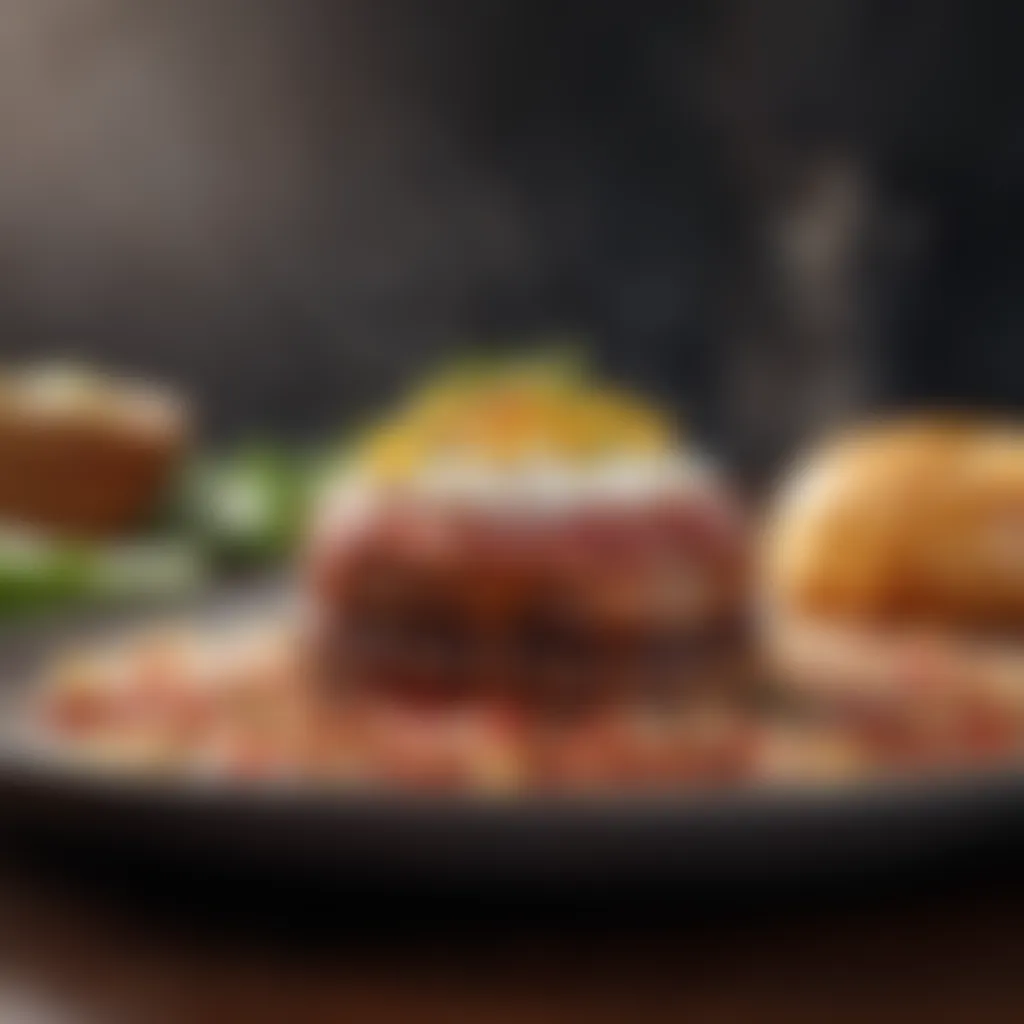
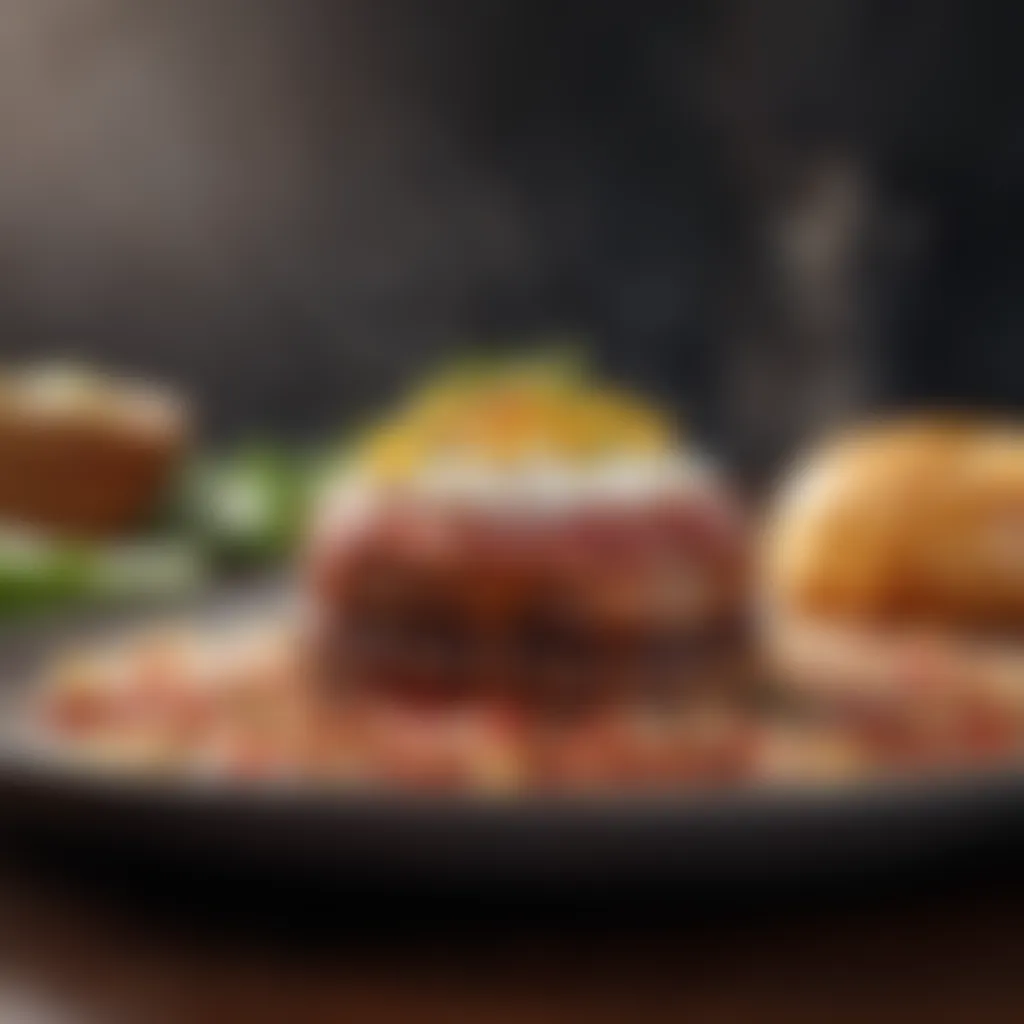
- Knead for at least 10-15 minutes until your dough feels smooth and elastic.
- It can help to rest your dough for a while; fifteen to twenty minutes can work wonders.
Shaping the Manda
With your dough prepped, it's time to shape the Manda. The process here requires a bit of finesse. First, cut your dough into equal pieces to ensure uniformity.
When rolling out each piece, aim for a round, thin circle, about the size of a small plate. If you're using a filling, don’t overstuff – less is often more in this context. Gently fold the dough over the filling and pinch the edges to seal them tightly.
Remember, the look matters! A well-shaped Manda not only tastes good but also makes for an appetizing presentation.
Cooking the Manda
Finally, we reach the cooking stage. The method you choose will depend on personal preference and tradition but here are some common approaches:
- Steaming: This is the traditional method, yielding a soft and fluffy Manda. Ensure your steamer is adequately heated and use parchment paper to prevent sticking.
- Pan-frying: For a crispy skin, try this method instead. Just a touch of oil in the pan can provide that satisfying crunch on the outside while keeping the inside soft.
The cooking time typically ranges from 10 to 15 minutes, but keep an eye on them! The golden rule is to trust your instincts – a well-cooked Manda should be firm yet springy.
Cooking Manda should feel like an art, not just a task. Enjoy the process, and the results will follow!
By following these detailed steps, you'll end up with a delightful spread that'll impress anyone who tries your Manda. The blend of tradition and technique is where true culinary mastery lies.
Troubleshooting Common Issues
When embarking on the journey of mastering the Manda recipe, it is vital to face the hurdles that may arise during the cooking process. Understanding common issues not only helps to refine your culinary skills but also ensures that the final product aligns with your expectations. Each cooking experience presents an opportunity to learn, refine, and make adjustments that can significantly improve both texture and flavor. The importance of troubleshooting cannot be overstated; it's the difference between serving a disappointing dish and creating a standout culinary delight. Here are some common issues you might face and how to address them.
Texture Problems
Achieving the perfect texture in Manda can be tricky. A dry or crumbly texture often signifies that the dough hasn’t been mixed properly or that too much flour was used during the kneading phase. This can leave you with a result that is far from satisfying. On the flip side, if your Manda turns out too soggy, it might be due to over-hydration or not allowing the dough to rest properly.
To remedy a dry mixture, gradually add small amounts of water or other wet ingredients until you achieve a smooth consistency. Remember, kneading is just as crucial. Proper kneading develops gluten which lends elasticity to your dough, giving it that desirable chew.
Conversely, if the dough is overly sticky, sprinkle flour in small quantities until it becomes manageable.
Some tips to ensure an ideal texture:
- Do not rush the kneading: Take your time to knead for at least 10 minutes.
- Check moisture levels: If you're in a humid environment, you may need to adjust the flour measurements.
- Resting period: Let the dough rest for about 30 minutes; it helps in developing the texture.
"Cooking is not just about the flavors; it’s equally about the textures you create."
Flavor Adjustments
Flavor is where the magic happens in any dish, and making adjustments can take your Manda from good to unforgettable. If you find that the Manda lacks a certain zing or depth, there are simple tweaks you can experiment with.
Perhaps you're discovering it tastes a bit bland or doesn’t quite match the essence of your cultural inspiration. This could stem from the choice and quantity of seasonings as well as the freshness of your ingredients.
To amp things up, consider these strategies:
- Incorporate herbs and spices: Fresh cilantro or a hint of cumin can elevate the flavor profile.
- Adjust sweetness or saltiness: A pinch of salt or a splash of citrus can balance out flavors beautifully.
- Experiment with fillings: If your Manda is traditionally stuffed, don’t hesitate to try different combinations such as spinach and feta or maybe a spicy meat mix.
Each culinary experience is about growth. Remember, a good flavor balance is foundational in crafting a dish that resonates with those who taste it. Fine-tuning your Manda’s flavor will not only satisfy picky eaters but can surprise even the most discerning palates.
Serving Suggestions
Serving suggestions are crucial when it comes to elevating your Manda dish from simply edible to something truly memorable. A well-served dish not only pleases the palate but also entices the eyes. Presentation matters, especially in cultures where meals are a celebration of flavors and artistic expression. In fact, the way you serve Manda can enhance its flavors and impact your overall dining experience.
When considering how to present your Manda, think about the balance between taste and aesthetics. Side dishes, garnishing, and even serving utensils can all influence the overall appeal. Let's delve into two main aspects: pairing with sides and effective garnishing techniques.
Pairing with Sides
Choosing the right side dishes to accompany Manda can make all the difference. A harmonious blend of flavors across the plate invites diners to savor each bite. Consider offering sides that complement the flavors of Manda without overshadowing its unique profile. Here are some delightful options:
- Pickled Vegetables: The acidity of pickles cuts through the richness of the Manda, providing a refreshing contrast.
- Steamed Rice: A neutral side can enhance the meal without competing with its bold flavors.
- Spicy Chili Sauce: For those who enjoy some heat, a spicy sauce can add a kick that brings out the spices in Manda.
When preparing these sides, consider not just their flavors, but also their textures. A combination of crunchy, soft, and even creamy can create an exciting mouthfeel.
"Presentation is not just about the dish itself; it's about the story it tells on the plate."
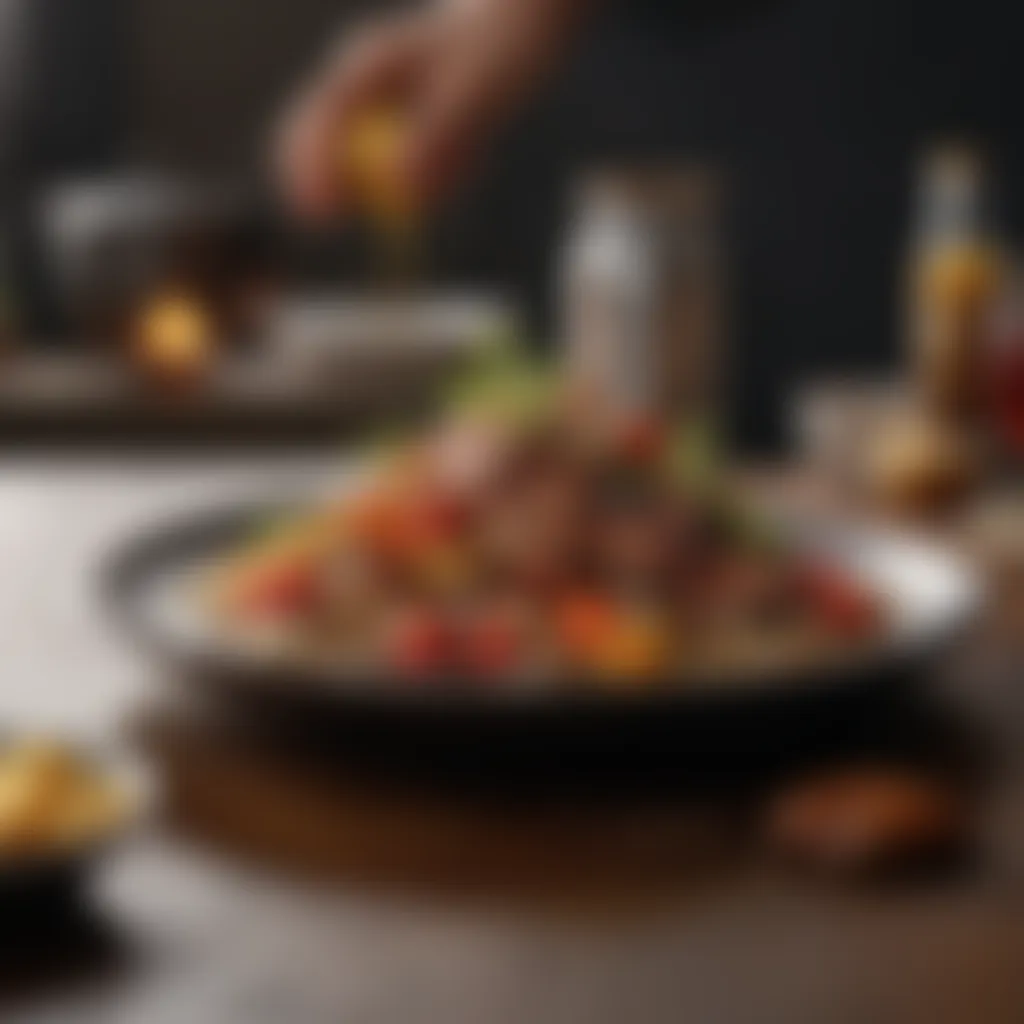

Garnishing Techniques
Garnishing is an art form that can take a dish to the next level. It’s not merely decorative; the right garnish can add layers of flavor, contrasting textures, and enhance the overall aesthetic.
Here are some techniques to consider:
- Fresh Herbs: Chopped cilantro or parsley can add a pop of color and flavor.
- Edible Flowers: Use them sparingly for an elegant touch that speaks volumes about the care put into the dish.
- Citrusy Zest: A sprinkle of lemon or lime zest can brighten the dish, adding a refreshing aroma that whets the appetite.
By using thoughtful garnishes, you can impart a narrative to your Manda serving that resonates with both tradition and personal touch. Balancing flavor, aesthetics, and texture will immerse your diners in an unforgettable culinary experience, enhancing not just their meal but the moments shared around the dining table.
Nutritional Analysis
Understanding the nutritional aspects of the Manda is crucial for anyone wishing to enhance their culinary skills while keeping health in mind. This traditional dish, with its layered flavors and textures, can be deceptively rich. By diving into its nutritional analysis, we can appreciate not only the tastes but also the benefits it offers. A proper nutritional breakdown highlights the ingredients' role in a balanced diet and informs us about how Manda might serve various dietary needs.
Caloric Breakdown
When it comes to caloric content, the Manda can pack quite a punch. A typical serving might contain anywhere from 250 to 400 calories, depending on factors such as the preparation methods and the choice of ingredients. Let's break down some key components:
- Carbohydrates: As Manda often includes elements like flour or rice, a significant portion of its calories will come from carbohydrates. A serving might provide about 40-60 grams, which is essential for energy.
- Proteins: If you incorporate various proteins—like meat or legumes—the calorie count rises, but you also gain muscle-building benefits. A protein-rich Manda can have up to 20 grams of protein per serving.
- Fats: The fats can vary widely based on the oil used. Opting for healthier oils can mean healthier fats, typically around 10-20 grams.
"Balancing ingredients with their caloric contributions can lead to a fulfilling meal without tipping the scales too much."
Health Benefits
Manda is not just tasty; it's surprisingly beneficial too. Here's a glimpse into its health benefits:
- Rich in Nutrients: Thanks to ingredients like legumes, fruits, or vegetables, Manda can be a powerhouse of vitamins and minerals.
- Dietary Fiber: Many Manda recipes include whole grains, encouraging digestive health and promoting heart health by assisting in cholesterol management.
- Versatile Meal Base: It can be customized to suit vegan, vegetarian, and gluten-free diets—making it a perfect option for diverse eaters.
- Comfort Food with a Twist: Traditional dishes can provide psychological well-being, offering a taste of home; coupled with nutritious ingredients, this is a win-win.
Incorporating Manda into your diet can mean enjoying comfort while keeping an eye on health—balancing pleasure with well-being.
Exploring Variants Across Cultures
Understanding the various ways Manda is prepared and enjoyed across different cultures opens a fascinating window into the dish's adaptability and significance. It is vital to acknowledge that Manda is not merely a culinary item; it embodies history, tradition, and the influence of local flavors and customs. By delving into these variants, readers can enrich their cooking experiences and appreciate the dish's depth beyond its recipe.
Regional Differences
Different regions put their spin on Manda, which showcases their unique culinary identities. For instance, in some parts of India, like Maharashtra, Manda is often flavored with coconut and jaggery, which gives it a distinct sweetness. In contrast, areas in southern India might lean toward adding spices like curry leaves or even chilies, offering a savory punch.
- Spices: The choice of spices differs widely. While one region may favor coriander and cumin, another may opt for an infusion of star anise or nutmeg. Each choice offers a unique profile that marks the dish as regional.
- Cooking Methods: The cooking process can vary too. Some regions steam the Manda, creating a softer texture, while others may adapt it for frying, leading to a crispier finish. This is where local preferences for texture come into play.
- Accompaniments: What’s served alongside Manda can also differ significantly. In some cultures, it’s paired with yogurt or a tangy chutney, while others may opt for a spicy salsa-style topping that complements the sweetness of the dish.
These regional variants not only reflect the availability of ingredients but also underscore the importance of cultural nuances in culinary practices. Understanding these differences can inspire home cooks to experiment and appreciate their personal touch in the art of making Manda.
Fusion Adaptations
Fusion adaptations of Manda bring a contemporary twist that blends diverse culinary influences. Many home chefs today look for ways to modernize traditional recipes without losing their essence. This leads to interesting and delicious outcomes.
For example:
- Mexican Influence: Some cooks experiment by incorporating elements of Mexican cuisine, such as using corn flour instead of rice flour, creating a more textured base that plays nicely with the flavors of Manda.
- Asian Infusions: A chef might add sesame oil and soy sauce, tuning the classic dish toward Asian flavors. The result is an intriguing hybrid that combines the original Manda’s sweetness with a salty, umami depth.
- Western Innovations: Western chefs may even transform Manda into a stuffing for gourmet dishes — think Manda-stuffed bell peppers or even a fancy brunch wrap.
Ultimately, fusion adaptations should be approached with respect for the original Manda. It’s about finding a balance between honoring traditions while also embracing creativity.
The beauty of culinary arts lies in its evolution. Manda, as it travels through time and cultures, continually reshapes itself, keeping the essence alive while inviting delicious innovation.
When exploring variants across cultures, it’s paramount to remember that these adaptations and regional differences do not diminish the core identity of Manda; they expand it. By understanding and savoring these nuances, home cooks can achieve a richer culinary experience that reflects both their heritage and the world around them.
Culmination
The conclusion of this comprehensive guide serves a vital purpose in summarizing the intricate journey through the art of crafting a perfect Manda. It encapsulates the entire method, from understanding the ingredients to appreciating the dish's cultural significance. It’s your moment of reflection on everything that has been learned, reinforcing the critical elements that contribute to mastering this delightful recipe.
One of the key elements of this section is its function as a consolidation point for the reader. By revisiting the essential aspects that have been covered, housewives and culinary enthusiasts alike can recall the intricate details that matter most—the texture, the flavor balance, and even the serving techniques that elevate the dish into something spectacular. Nailing down these points can prompt readers to revisit earlier sections of the guide, encouraging a deeper understanding and fostering a hands-on approach to cooking.
Key Takeaways
- Holistic Understanding: Each cooking step is interconnected, emphasizing the importance of methodical preparation. The way you source and judge your ingredients directly affects the final result.
- Cultural Significance: Recognizing where Manda fits within its culinary context underlines the importance of tradition in modern-day cooking. This appreciation can lead to family stories being passed down through the generations.
- Problem-solving Skills: Identifying common mistakes and knowing how to troubleshoot solidifies one’s cooking skills. You’ll feel more equipped to tackle variations as confidence grows.
Final Thoughts
In closing, the journey to mastering the Manda recipe is not merely about making a dish but rather engaging with culinary history and experiencing the love of food. By following the detailed method presented throughout the article, you have an opportunity to explore your creativity while respecting tradition.
Cooking the Manda is a delicious venture that combines flavors and histories in every bite. As you embark on this culinary adventure, remember it's not just about feeding bodies but also nurturing connections and stories that linger long after the meal is served.
"Good food brings people together—like friends and family around the dinner table."
So, roll up your sleeves, gather your ingredients, and savor the joy of creating something truly special.







